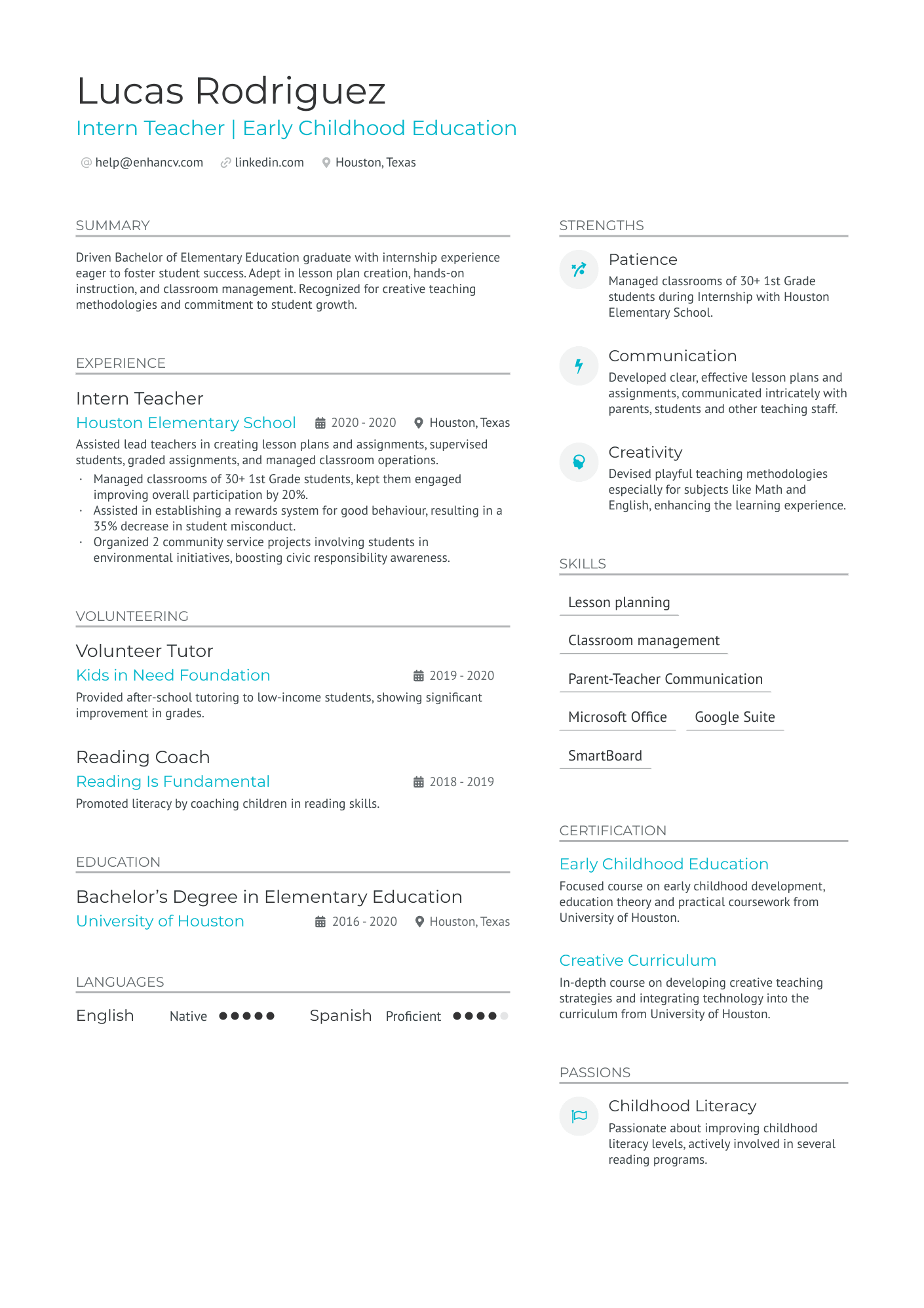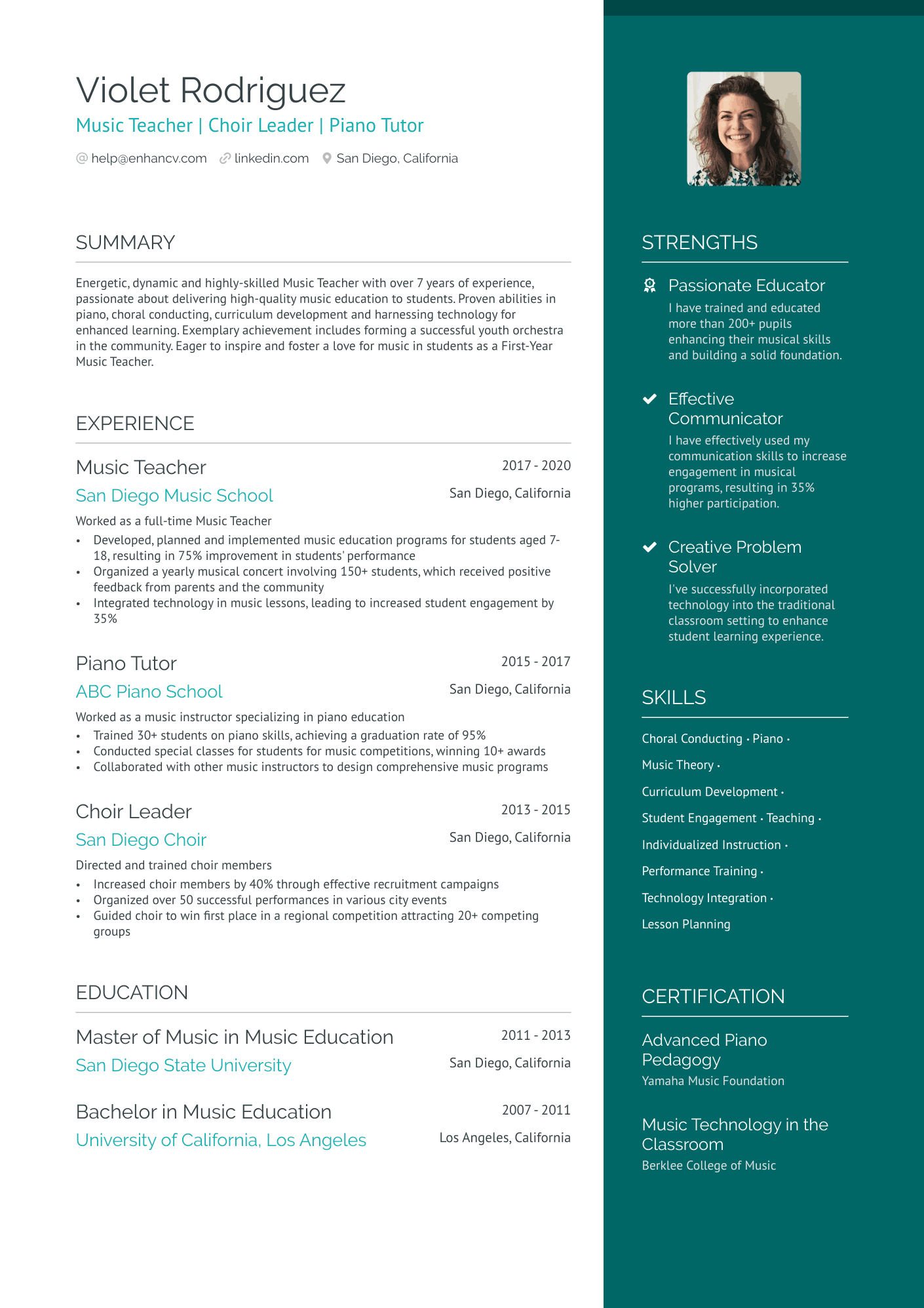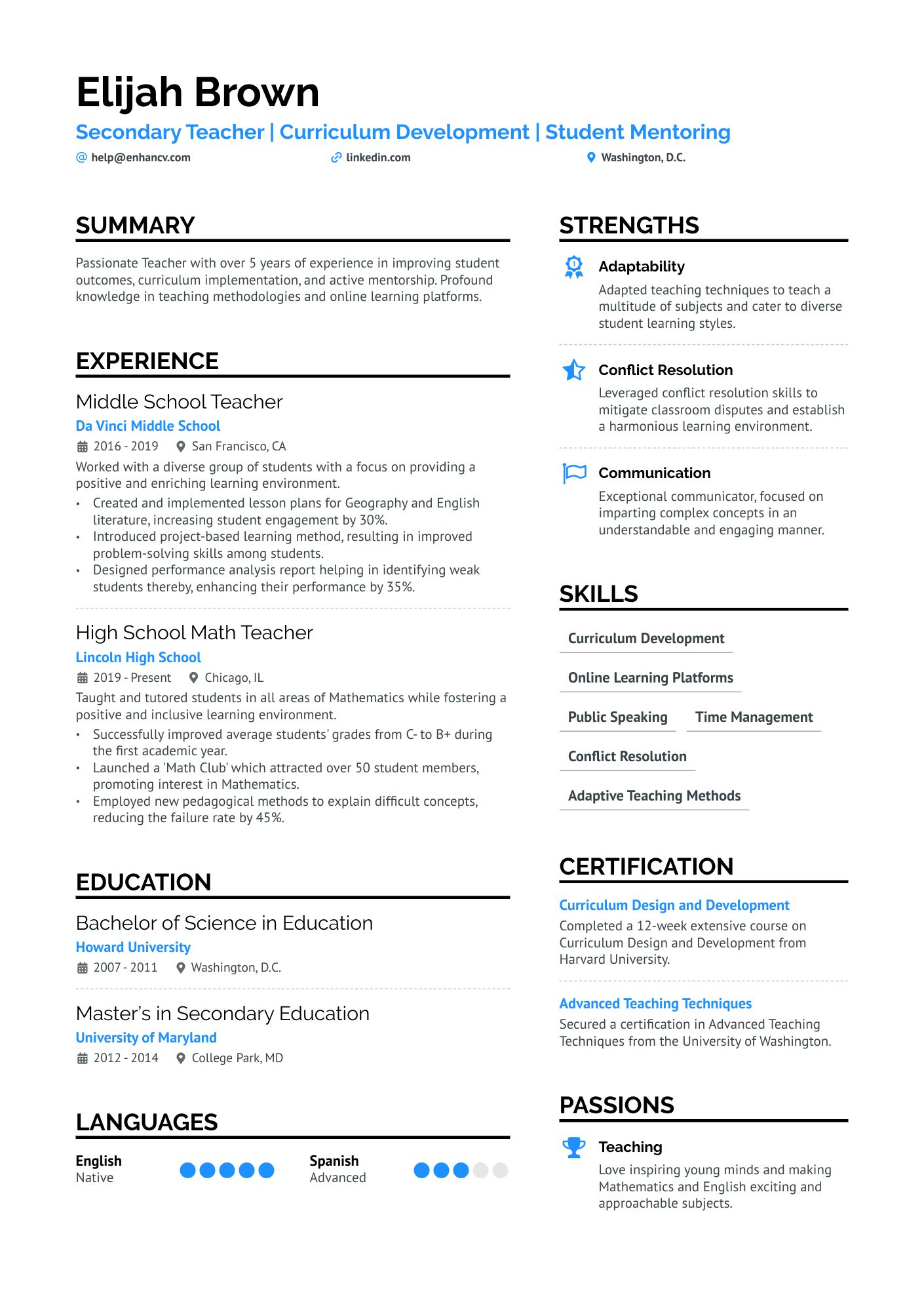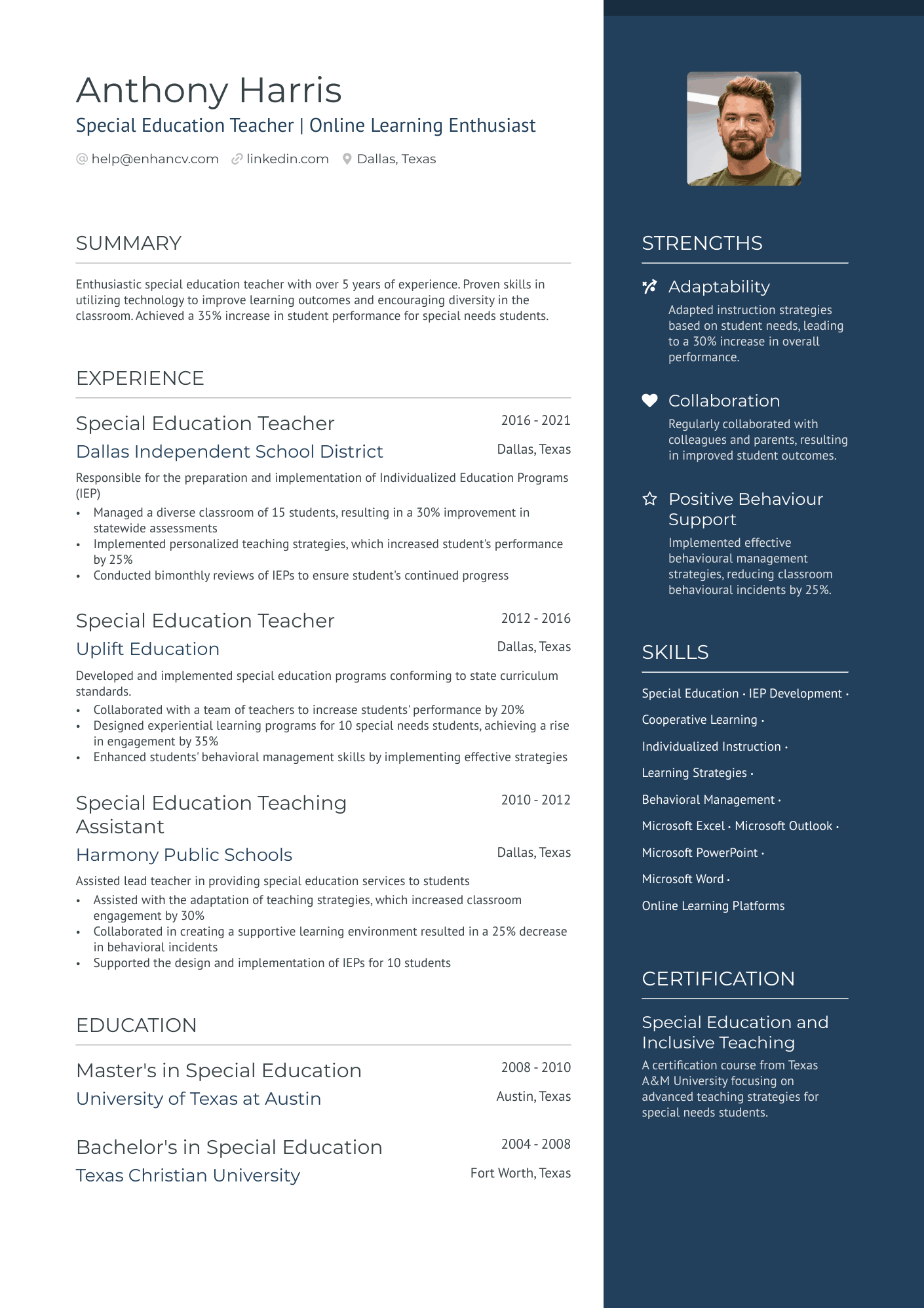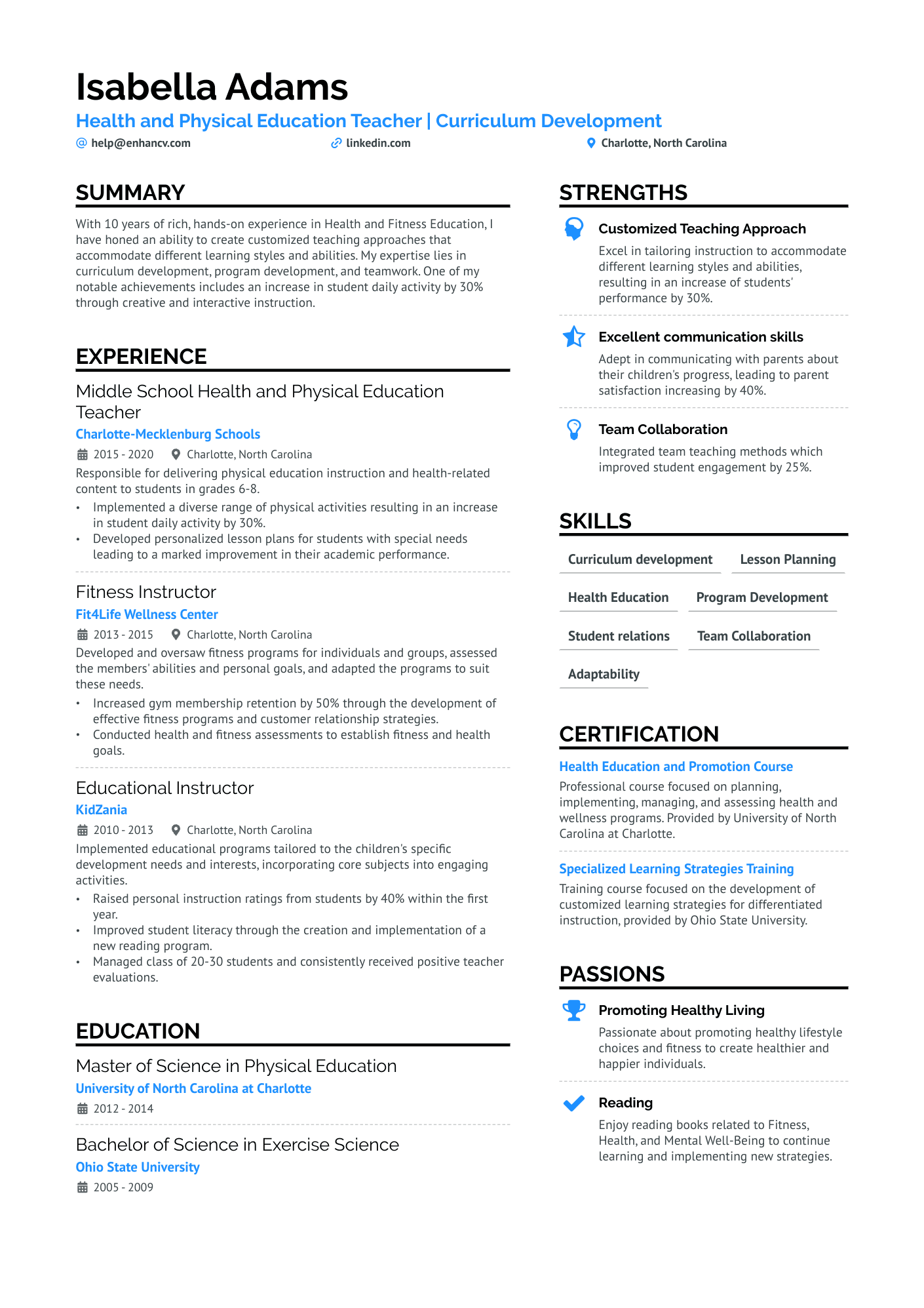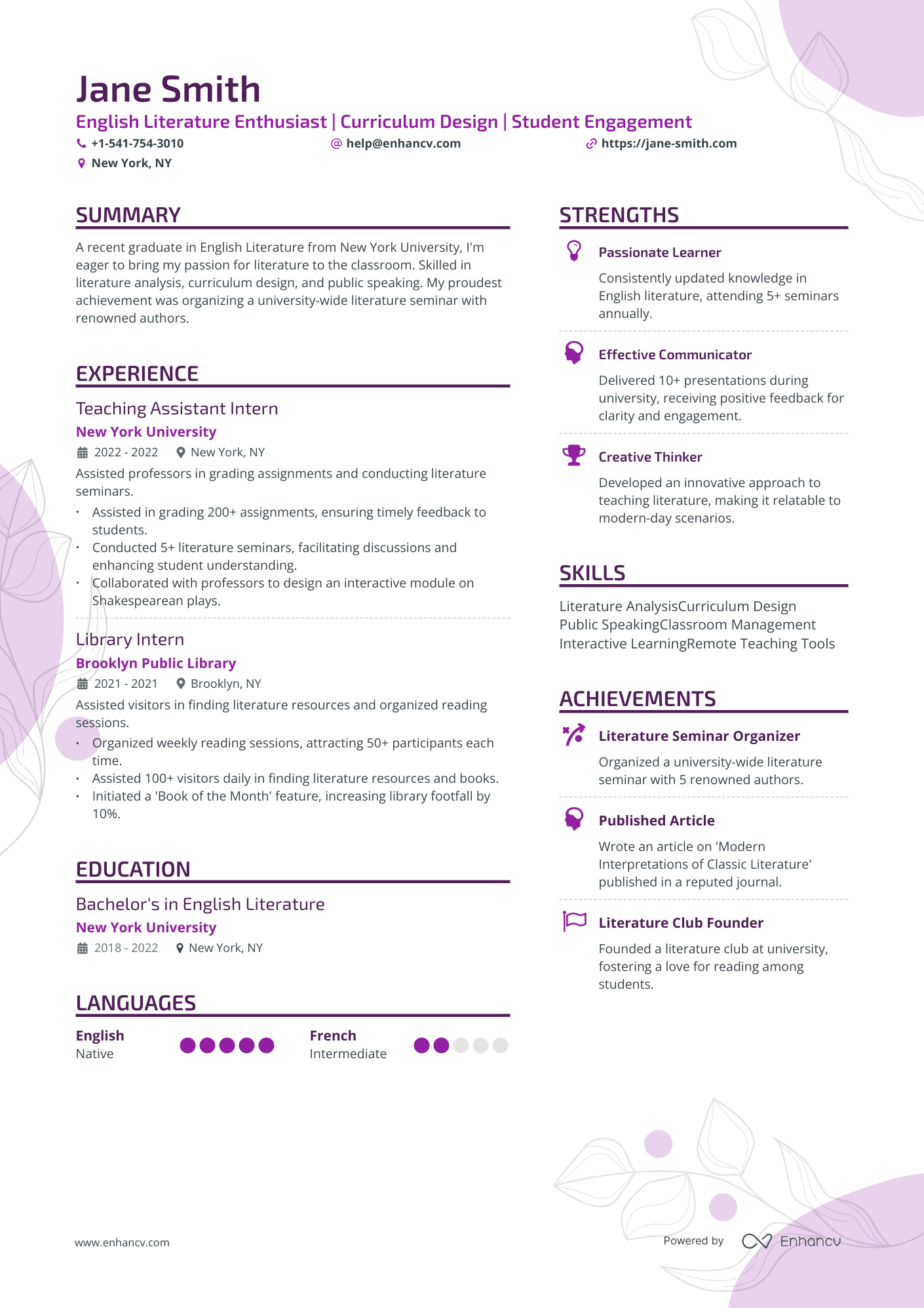Being brand new to the teaching world allows you to see things with fresh eyes and to teach with enthusiasm and passion. Through your classroom work and practical experience you’ve soaked up, you know what it takes to make a difference in the lives of young people. You have tons of potential, but not a lot of real-world experience, which is exactly what school administrators and principals are looking for. What you need to do is write a stellar first year teacher resume to showcase all that you have to offer.
In this article, we’ll be focusing on:
- An example of a great first year teacher's resume
- The primary skills and experience you want to highlight on your resume
- What is the best resume format for primary teachers?
First year teacher resume example
The first thing that you notice on this resume is its creative flair.. For example, the whole right column of the page, which includes the “strengths”, “skills”, and “achievements” sections, uses vibrant colours and graphic design elements to better convey the message.. They say that a picture speaks a thousand words. This is especially true if you are a classroom teacher because one of your primary responsibilities is to create compelling teaching materials for students. This resume points to an attention to detail, setting it apart from other applicants..
In addition, when you look over this resume and you see someone who is a go-getter, someone who is willing to try to make things happen. Not only did they organize a university-wide literature seminar with renowned authors, they also had one of their papers published in a peer-reviewed journal. A hiring manager will see this and realize you are a lifelong learner.
How to format a first year teacher resume
Depending on how you performed in school, getting a report card back was likely one of the most scary times for you. If you’re like most students, you might’ve received a note on your report card like this, “lacks attention to detail”. If you don’t properly format your resume, administrators and principals may see that as lacking attention to detail.
Let’s dig a bit deeper into what you need to do to format your resume:
- Reverse chronological order: Using this format allows you to showcase your most recent experience first at the top of the page. This format allows you to showcase your career trajectory, and as a first year teacher, this will come in handy because you can show all the practical teaching experience you’ve picked up.
- Header, contact info, photo: Your header contains all the information that a hiring manager needs to be able to contact you. In your header, make sure to include your name, phone number, location, email address, and other important professional information like a portfolio. In addition, you may wish to include a photo of yourself.
- How many pages: Although there is no rule set in stone on how long your resume needs to be, it’s best to keep it to between one to two pages in length.
- File Format: Unless otherwise requested, the best format you should use for your resume should be a PDF, as it is easier to share, and doesn’t have the same issues with images and text shifting around.
The top sections on a preschool teacher resume:
- Resume Summary: Your resume summary is your first opportunity to share about your goals and aspirations for your career with a hiring manager. It should be short, between two to four sentences, and should focus on specific skills and abilities that you bring to a teaching environment.
- Experience: Although you may not have a lot of practical experience, you’ve no doubt been able to showcase your teaching skills and abilities throughout college, getting much-needed exposure. Don’t be afraid to list unpaid or volunteer experience in order to bolster your resume.
- Education: As somebody new to the teaching profession, your education may carry more weight than on a more experienced resume. The reason for this is that a school administrator may see where you went to college, and they may have experience with the teaching program at your alma mater. This might actually give you a foot in the door when applying for a teaching position.
- Skills section: Your skills section can make you stand out from the crowd. In your skills section, don’t be afraid to brag about yourself, listing your most important skills that are applicable to the position.
- Certifications, licenses, and awards: In a teaching role, being able to fit a niche within a school can help you get hired. For example, if you have experience with special education and working with those who have disabilities, you might be seen as more valuable and have a higher chance of being hired.
What recruiters want to see on your resume:
- A stellar track record for creating creative lesson plans which captivate students.
- Effective classroom management techniques which apply to the specific grade and position you’ll be applying for.
- The flexibility to handle diverse tasks in a calm, organized manner.
- Superb communication skills with parents, school administrators, and other staff, maintaining an open line of communication between teachers and parents/ guardians
- Conflict management skills which show adaptability and competence when dealing with difficult, disruptive, and disrespectful students.
- The desire to learn and stay up-to-date with current trends in teaching.
How to write your first year teacher resume experience section
As mentioned briefly above, your experience section can make all the difference when applying for a position. Even if you have absolutely no practical classroom teaching experience, you’ll likely have gained experience through your university education or volunteer experience in the past.
It’s up to you to comb through all of your previous work and volunteer experience to find the ones that most apply to a teacher role.
Do your best to quantify all the claims you make in your experience section. Resumes fall flat when they just become a list of things you’ve done, rather than authentic examples of how you improved your workplace through your hard work.
- •Shadowed an eighth-grade teacher, soaking in valuable experience.
- •Lent a hand in creating papers and writing report cards.
- •Taught seven lessons on the Shakespearean play Macbeth and created an interactive presentation.
- •Graded over 100 papers, including standardized tests, and wrote over 150 unique report card sections to help pinpoint areas of improvement.
- •Created a unique lecture series on the Shakespearean play Macbeth, using interactive presentation elements, including video, PowerPoint, and costumes.
- •Promoted a professional learning environment which had an average parent satisfaction score of over 95%.
- •Completed an advanced qualification in special education, while also working closely with developmentally delayed students in the classroom.
What does this experience section do right?
As opposed to the first example, each bullet point showcases quantifiable real-world examples. They didn’t just help grade papers, but graded over 100 papers, including standardized tests, and wrote 150 unique report card sections. That shows a school administrator that you put in the time and effort to learn the ropes as a teacher.
The example above also shows that this teacher is willing to go the extra mile and list the creative elements in their presentation of Shakespeare’s Macbeth. In addition, this teacher gained a unique qualification as a special education teacher, which allows them to differentiate themselves from other applicants.
How to quantify impact on your resume
When crafting a resume, it’s always best to quantify all of your achievements. Although as a teacher you may think it’s difficult to put a number on some of the experiences that you have, it can be really helpful to show intangible ways you have helped to build into your students.
In fact, using real-world examples and numbers can help to show that you are credible in your role, able to handle many diverse tasks efficiently and effectively. This could be as simple as listing the median grade point average for standardized testing, showcasing how you helped your students to achieve an overall grade of 85%.
Below, you can find specific instances as a first year teacher which can be turned into quantifiable metrics:
- Improvement in student performance
- Parent satisfaction
- Classroom management
- Curriculum development
- Training and professional development
- Awards or specific recognition
- Number of students taught
- Progress your students have made in key development areas
How do I write a first year teacher resume with no experience?
It can be difficult to break into the teaching field. First-year teachers have an uphill battle to show that they’re competent and able to handle a classroom, manage parents’ expectations, and create an environment conducive to learning. If you don’t have a lot of experience, you can always lean on your past achievements, whether in work, school, or volunteering.
Below, you can find a list of advice to follow if you are crafting a first year teacher’s resume with very little experience:
- Create a compelling resume objective: Your resume objective is one of the most important parts of your resume, as it allows you to showcase not only your experience but also your goals and aspirations. Think of it like an elevator pitch: you have an opportunity to share more about yourself, what you’ve achieved in previous work experience, and what motivates you. The right length for a resume objective is between 2 to 3 sentences. It’s also an opportunity for you to share about your passion for early childhood education.
- Brag a bit about yourself: Confidently highlight all applicable experiences that you have under your belt. For example, if you were a camp counselor at a camp that dealt with kids who have behavioral issues, you can share that you help to manage expectations and create a healthy, fun filled environment. Don’t be afraid to scour through your previous experience to find specific instances where you went above and beyond expectations.
- Highlight your education section: If you’re fresh out of school, it’s always a good idea to add more to your education section to bolster your resume. For example, you may wish to include some information on projects that you completed while in university. You may also want to list your GPA and any other awards and achievements.
How to list your hard skills and soft skills on your resume
As someone new to the teaching world, you may find it helpful to highlight your skills section more than your experience section. Most teachers possess a good deal of soft skills, also referred to as “people” skills. But in your day-to-day experience, you’ve likely also mastered a lot of technical skills, also referred to as hard skills, including online presentation software and curriculum development.
Below, you’ll find two lists, one for the best hard skills and the other for the best soft skills to include on a first year teacher resume:
Best hard skills for your first year teacher's resume:
- Classroom management
- Curriculum planning
- Early childhood education
- Child development
- Behavior management techniques
- Observation skills
- Assessment and evaluation
- Storytelling
- Art and craft skills
- Language development
- Music and movement activities
- Remote Work Skills
- Basic computer literacy
Best soft skills for your first year teacher's resume:
- Motivation
- Critical Thinking
- Detail Oriented
- Communication skills (verbal and written)
- Patience
- Creativity
- Conflict resolution
- Multitasking
- Adaptability
- Leadership
- Time management
- Active listening
Pro tip
Many teachers have a hard time quantifying their soft skills. But you can easily do this by assigning a percentage or number to each of your skills. For example, don’t just list that you have cultivated time management skills, but mention the time management software that you have used to help cut down on report card writing by 25%.
How to list your certifications and education on your resume
If you’re the kind of teacher who likes to learn new skills, then there is no doubt you’ve taken a lot of certifications. In addition to your teaching degree, you’ve likely taken courses on early childhood education, teaching children with special needs, and even classroom management.
Here’s what you need to include when listing your education on your resume:
- The name of the degree
- The name of the school
- The location of the school
- The years you attended the school
- GPA (optional)
- Honors or extra-curricular involvement (optional)
- •Major: English Literature
- •Extra-curricular involvement: Debate club, Residents Assistant
Best certifications to earn as a first year teacher:
- English as a Second Language (ESL/TEFL) Certification
- CPR and First Aid Certification
- Special Education Certification
- Child Development Associate (CDA)
- Montessori Teacher Training Certification
- Child Protection and Safety Training
- Play-Based Learning Certification
- Direct Instruction Certification
- Bilingual Education Certification
What is a good objective for a new teacher resume?
Your resume objective is your first opportunity to showcase your passion for education to a hiring manager. Essentially, it is like an elevator pitch, a place for you to share your strengths and why you believe you’re the best person to fill the position.
It’s also a great place to showcase your career goals and aspirations. As a first year teacher, this can allow you to make a name for yourself and to position yourself as a passionate teacher.
Keep your resume objective short — between 2 to 4 sentences — as you don’t want it to take up too much space on your resume. The best resume objective gets to the point, showcasing who you are and why you’re the best fit in a role.
There are two major issues with this resume objective: it’s vague and boring. Using generic phrases like “interested in creating a healthy environment for children to learn” won’t cut it when you’re trying to present yourself as the top candidate to a hiring manager. Dig down a bit deeper, and you can find exactly what you’re interested in teaching. That’s what you want to share in your resume objective.
Not only that, but it also doesn’t have any tangible, quantifiable examples. If you can include some facts, figures, and percentages, you can help to show that you are credible in your role as a classroom teacher. Even if you only had a bit of experience, find one or two things that you can put a number behind. Check out the following example below and you can get a good idea for how to quantify your resume objective.
You may have noticed the numbers and percentages found throughout this resume objective. You might be asking yourself, “how exactly do numbers help in my resume?” Well, when you include facts and figures, you show your level of credibility by putting a number to it. You didn’t just help increase standardized test scores, but you did that by 15%.
Having those facts and figures can actually put you on the top of the resume pile. Most people consider their achievements, but they don’t ask themselves how much they achieved in their work.
Optimize your resume summary and objective for ATS
Drop your resume here or choose a file.
PDF & DOCX only. Max 2MB file size.
Additional sections for a first year teacher resume
- Teaching Philosophy: Your teaching philosophy can help showcase your own unique classroom management techniques, whilst also highlighting your individual values.
- Professional Affiliations: List memberships in educational organizations or unions. It indicates commitment to professional development.
- Volunteer Experience: Showcase non-paid roles in educational settings or community service. Highlights soft skills, leadership, and versatility.
- References: Include mentors, professors, or colleagues who can vouch for your skills and character. Preferably those who've seen you teach.
key takeaways
- First-year teachers may wish to highlight their skills on the same level as their experience using a hybrid resume format.
- Quantify all the claims you make on your resume, using facts, figures, and percentages.
- Although you may be lacking in experience, you can fill in your resume with sections, including certifications, volunteer experience, and your teaching philosophy.
- Highlight your education section to showcase your growth in the education field.
First Year Teacher resume examples
By Experience
By Role
